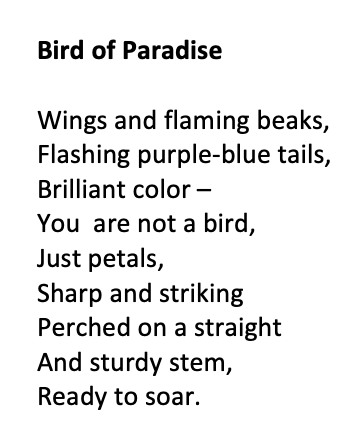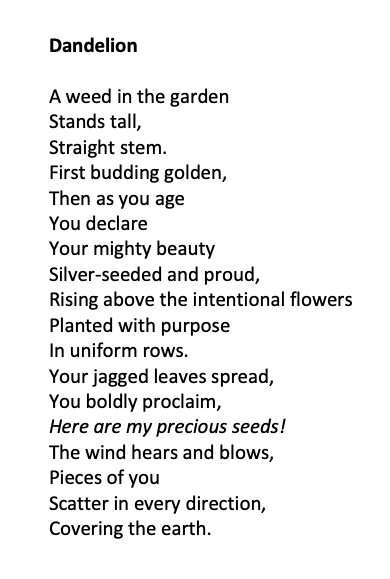This has been a heartbreaking week, a gut-wrenching month: senseless violence in Buffalo and Uvalde. Teenage gunmen destroyed lives while people shopped at a grocery store and children and teachers were busy in their classrooms teaching and learning. The rage in the minds of these individuals is unfathomable to me. And though this blog is about literature, art, and education, I cannot let this week go by without addressing the terrible loss and helplessness I feel due to this horrific tragedy. There must be solutions: stiffer gun control regulations, better mental health care, and stronger protection for our school and public spaces. This saddens me deeply. What is happening to humanity? Are we all to live locked away in our private residences with limited social contact? What will happen to us then? As these thoughts buzzed around my mind this week, I turned to nature, as I always do, for solace – for an answer.
Connection to nature, I believe, is a source for hope, well-being and mental health. This spring has been filled with flowers. There are flowers blooming around our school campus, flowering trees in my yard, and a plethora of flowers casting their spell over many local gardens. I pass by wild irises on the roadside, their purple tongues dotted with raindrops. I concentrate on their color and form. I wonder at such beauty, such grace, such an exquisite being, and I want to transform myself into that flower. I want to grow where I’m planted, feel the soil beneath my feet, spread roots, shoot up tall, and blossom.

When I began my teaching career, I worked with preschool children. We spent much of our time outdoors in both good and inclement weather. The children dug in the garden and were surprised when they pulled up carrots and radishes, believing there was magic in the soil. They loved to weed, water, and harvest. They felt control and accomplishment. Flowers served as a respite for us, a signal to stop and take in beauty, to breathe. The children would gather small bouquets for me of dandelions, clover, and buttercups. They would string flowers in each other’s hair and make magic potions from the bits of vegetation they collected. Life outside was a necessary part of their growth and development.
I remember a time, when one girl brought me a lovely red tulip. She had dissected it, separating its stem, leaves, petals and stamen. There were tears in her eyes as she held out her hands to me, “Put it back together,” she commanded. I looked at the flower and wondered, at first, how I could reassemble it for her. I took the pieces from her hands and placed them on the ground making a tulip mosaic. I knew this was not what my student had in mind. She thought I could mend it completely and make it whole again. When I explained to her that it couldn’t be brought back to life, she cried, and I consoled her. She learned that the flower was a delicate and fragile thing, something to care for, something to admire and cherish. And maybe flowers are part of the answer. They have been powerfully and wonderfully made. They are a gift from God to humanity to give us strength and make us resilient.
As often happens, a book popped out a me from our school library shelf wanting to be read. It was a new Caldecott Honor medalist, Have You Ever Seen a Flower? by Shawn Harris. It is brilliantly illustrated using simple tools: pencil and colored pencil. It is childlike and surprisingly powerful in its simplicity. The girl in the story asks the reader to really think about flowers: look deeply, take in their smells, watch them with a microscopic wonder. Watch them so closely that you can imagine what it feels like to be a flower: to grow roots, take in water, and bloom. The book reminds us to use the flower like a resource – to grow, thrive, and blossom. Flowers help us reflect, turn inward, and respect life.
I went searching for solace this week. I went hunting for answers. I found them in the form of flowers and poetry. Once destroyed, lives cannot be put back together. Some things cannot be made whole again. But I believe that the solution for violence must be in a turn towards nature, towards beauty, towards the preciousness of life. Consider the flower.







Wow/ I needed your post. I needed to hear that others are sharing the disorientation and sadness that this week brings. For teachers, it is particularly intense and surreal too. Nature calls to us if only for a moment. Our world is miraculous and more than any of us humans deserve. Thank you for celebrating its majesty and healing properties. Love this blog so much! With gratitude—T
LikeLiked by 1 person
Thank you TIna. Your words and support mean the world to me!
LikeLike
Powerful, my friend. Thank you.
LikeLike
When I think of flowers and children and wild colors – I think of you! Thank you for bringing beauty to the world.
LikeLike
Oh, that story of the young girl who brought you the red tulip and learned that it couldn’t be put back together again. No wonder you have held onto that story across the years. It is poignant.
I, too, wrote about Uvalde last week (https://twowritingteachers.org/2022/05/26/uvalde/). I am furious about the way this keeps happening. My father spoke to me on the phone this morning and we were talking about it. He noticed that something changed in my voice. I don’t hear it, but he’s probably right since he knows me best. I’m fired up because no family should have to cope with a traumatic injury or death from a shooting. This just cannot continue.
Yes, we must look to nature to heal us in times like these. There is something so important about the natural world every day, but especially now.
LikeLiked by 1 person
Thank you, Stacey. I pray that not one more family will have to suffer this kind of loss. I imagine that school room, that grocery, and cannot fathom the hatred that could cause anyone to create such profound pain and tragedy. It is almost too much to bear, and so I must turn to nature. Your post actually gave me strength to voice my feelings. Thank you again.
LikeLike
This post was a lovely response to a tragic and terrible week. Thank you for it.
LikeLike